(September 11 – written by Dave)
Day 4 – La Pine to Diamond Lake – 0k/0ft
We were pretty cold in the tent overnight and knew why when we went out to look at the coffee marquee tents. They all had large chunks of ice where the overnight rains had pooled on their tops. Unfortunately, there was very little call for iced coffees from our customers so we had to discard the free ice. It was good that we pre-boiled the brewing water last night as well – room temperature water was pretty cold, as in frozen! We have large Cambros to store hot water, and coffee in and we fill them each night with hot water to reduce the time to get hot water in the mornings.

It was pretty darn cold – I’m not sure about the nutter in shorts is standing in front of our booth!
Participants slowly made their way through the fog-covered field over to the food hall, many stopping at our coffee tent for something to make the morning better. It wasn’t raining but boy was it cold. Lots of numb fingers and grumblings – Nancy had one customer say he had had it, this was supposed to be a vacation and he was going to call his wife to come pick him up!
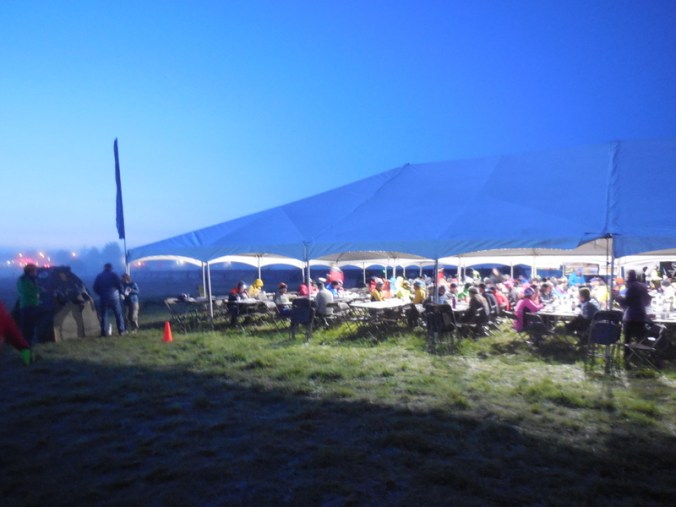
Cold and foggy, but you can see some blue sky at the camp dinning tent
Today was our day to drive the vans. We probably could have ridden as three other team members were also looking to avoid riding the 92 mile day, but we’d already made up our minds and the cold morning sealed the deal for us. We broke camp and hit the road by 9:30 or so to make our way to Diamond Lake, the next stop. All of the various Cycle Oregon trucks and support vehicles move to the next location generally on different roads than the cyclists take to avoid spoiling the ride for the riders with too much traffic. Some days the truck route is longer, some days it is shorter. Today the truck route was shorter.
Due to the shorter route and the longish cycle, we reached camp long before any riders. We arrived at camp well before noon and got the entire team’s tents set up in a great camp spot in the sun right on Diamond Lake. We had the coffee marquee and prep areas all ready to go well before the bulk of the riders showed up. The rains of the past three days became a distant memory pretty quickly as we set-up everything up – by mid-afternoon we were all in shorts and short sleeves.
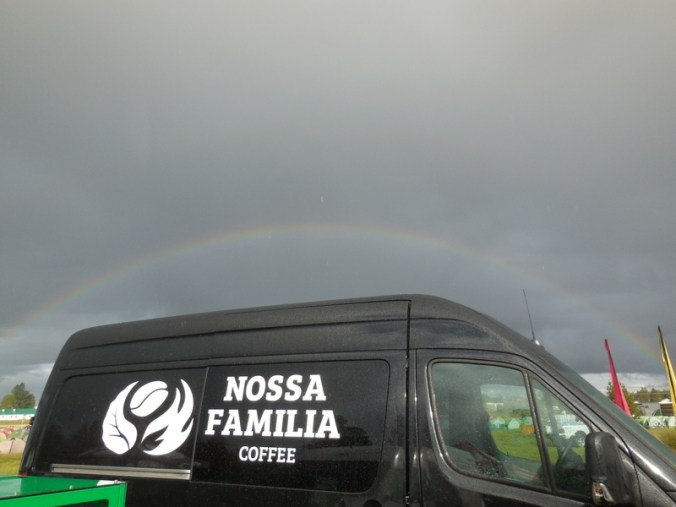
Coffee van the night before – rain means rainbows
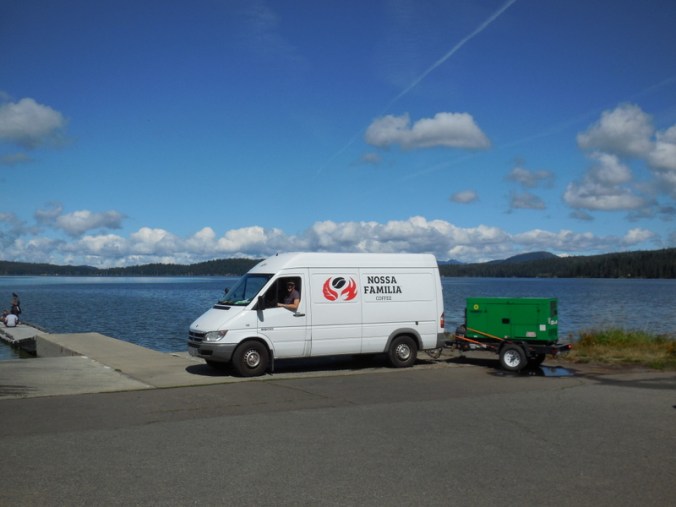
What a difference a couple hours makes – on the shore of Diamond Lake
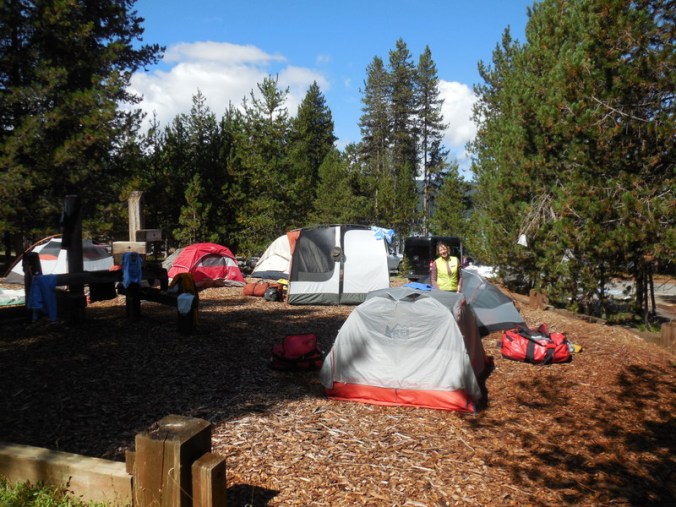
Our group tent site for two nights – in the sun
Since we didn’t get to ride, rather than a ride update today I’ll provide more information on the coffee experience. Yesterday we talked about the different roles in the coffee set-up. Today I’ll share a little more about the coffee operation.
One of the vans has a proper espresso machine. We pull a large generator behind one of the vans to power the machine. This means that we get to sell all types of espresso drinks, just like a normal coffee shop. There are two double headed espresso points on the machine. One person stands in the van all morning pulling shots. A second person handles steaming milk and making the actual drinks. Three to four people work the front of house, selling drinks, running cups and finished coffees and keeping customers happy.
While I think front of house was hard work and I like a proper flat white (which is made with espresso), I’m really keen here to tell you about our brewed coffee. Not just because I became one of the team’s brewmasters, which was cool, but more because the brewing was on an industrial scale that merits a full blog on its own.
When we made coffee in the mornings, we made it in 5 gallon batches. That’s right, 5 gallon batches. We used 3.25 pounds of pre-ground coffee for every batch. We made 3 to 5 of these batches per morning, depending on customer demand. We also brewed fresh coffee for our afternoon service. The press is essentially a large aluminium pot that Augusto has modified with a spigot and giant press. See photo below.
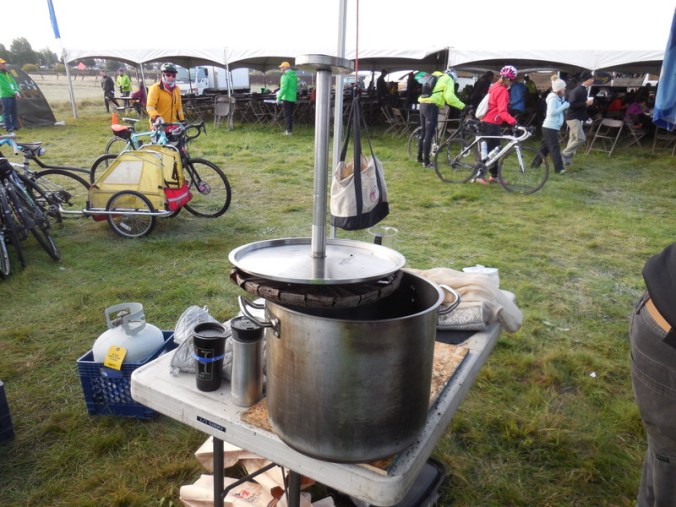
The press kettle
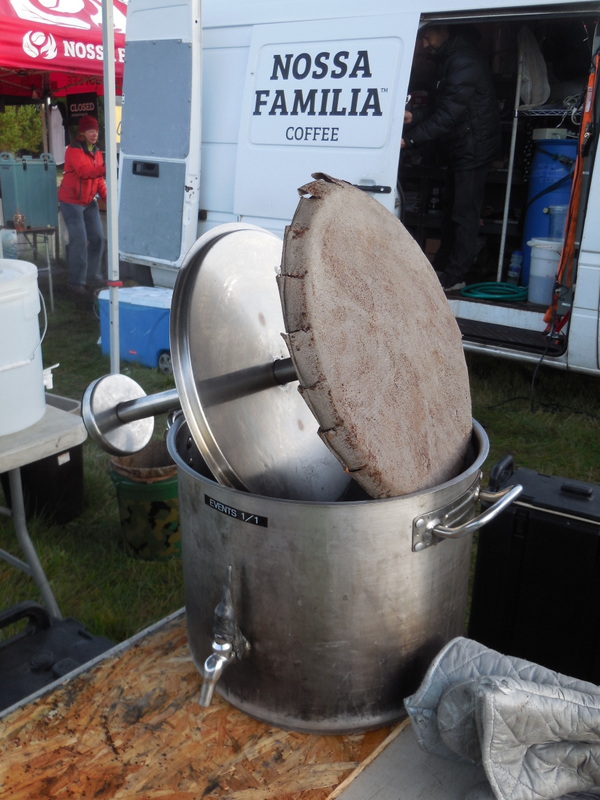
Different view of plunger and spigot
The ten step instructions for making coffee from the training manual are below. The italicised sections are what we did onsite that was different to the guide, based on instructions from Brewmaster General Augusto, or additions to provide clarity.
- Add 6 gallons of water to the giant French press and then bring to a boil.
Boiling is done on large crab-pot-like cookers that is connected directly to a full sized propane tank. Lighting the burner is made somewhat challenging as the gas flow is so high that it often extinguishes the lighter flame. For safety, a lit burner should never be left unattended – we had two fire extinguishers onsite.
- When the water is at 205 degrees (just off boil), add 3.25lbs of coffee, ground coarse (1 pre-measured, pre-ground bag). Start the timer for 6 minutes.
We didn’t have a thermometer to check the water – we just brought it to a boil figuring that the super cool morning air would cool the water more than enough before we got the coffee into the water.
- Stir the coffee with a large spatula until the grounds are all wet and incorporated.
- Stir again when 2 minutes has elapsed, then again when 5 minutes has elapsed.
Even though the instructions guided us to stir twice, Augusto’s personal onsite training had us scale this back to a single stir at the 3 minute mark.
- If it is cold outside, cover with a flat lid between stirs.
We covered brewing coffee all the time – it was cold every morning!
- When nearing 6 minutes, remove the flat lid, carefully insert the press lid and slowly press the plunger all the way down.
The press is getting old and has been well-used. It needs to be inserted with great care so that it presses without leaking.
- After pressing, lift the kettle (2 people, with oven mitts!!!) onto a table with a piece of wood on top.
We actually lifted the kettle after it was boiled, step 1. This was yet another modification that we picked up from Augusto in our training session on the first morning. That way, if we had any trouble moving the pot we were spilling water only, not the premium coffee that Augusto works so hard to get!
- Put a Cambro on the ground under the kettle’s spout, with a small strainer over the mouth of the Cambro, and a cloth toddy nylon strainer bag nestled in the strainer to catch finer grounds.
- Open the kettle’s spigot and dispense into the Cambro. A Cambro can hold around 4.75 gallons, so be sure to watch the dispensing – you may need another container.
We had four coffee Cambros on the trip (a separate Cambro was used for hot water to ensure water for tea was clean without any coffee taste). We’d fill three of them with two brews. By that time we finished the second brew, the first Cambro would be emptied by customers and a third brew followed straight away.
- To clean the brew pot and press, remove the press lid and knock as many grounds off as possible into the compost bucket. Then clean/rinse the grounds out of the press. Scoop out the spent grounds out of the brew pot into the compost and rinse as well as possible, and repeat.
Great care needed to be taken with the plunger. We got to the point that we didn’t dare even tap it for fear of breaking. We had to “MacGyver” the press handle mid-trip – it has been heavily used over the years Nossa has been serving coffee for Cycle Oregon. Augusto has teamed up with the University of Portland’s engineering school to design a new press – we can hardly wait to see what they come up with. Augusto filmed us one day going through all the steps to give the students a guide.
Follow all those steps and the result is 5 gallons of very good pressed/brew coffee. For the most part all of the brews on Cycle Oregon 2019 were completed by Kris and me. We were both complete rookies on the first day but we because we had the press’s inventor Augusto provide us with personal training sessions it was easy to nail the process.

Fellow brewmaster Kris in his full cold dark morning gear
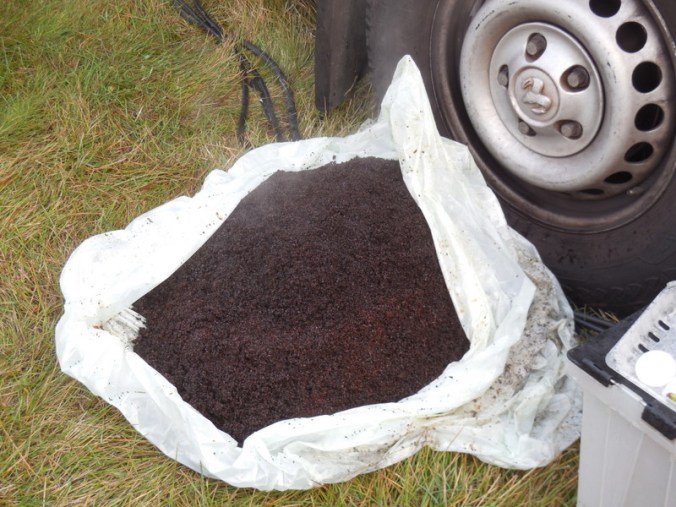
The used coffee from every day makes a big pile – this is one four brew day – we composted all of the used grounds in the Cycle Oregon food compost bins
In the spirit of full disclosure, somehow, both Kris and I each started a coffee pour during the week without first pressing the coffee (step 6). I’m not sure why, but the pressing step is one that was easy to forget. We caught this pretty quickly as the coffee coming out of the spigot was a wee bit gritty even to the naked eye. Of all the other possible errors we could have made, the only major one that I can recall was forgetting to close a Cambro spigot as it was being filled with coffee. To protect the members of the brewing team, I will not be naming the brewmaster who made this error.
Later in the week, Karen (our event leader) and Geoff (another senior member of the team) had a conversation about which job on the crew was the hardest. They concluded that it was the brewmaster. With no disrespect to Kris and our great brewing team efforts, I’m not sure that I can say that we had the hardest job. Totalling a customer’s order who wanted 4 different drinks, some with special milks and syrups, some with personal cups, some without – all in one’s head at 5AM in the morning – well, the front of house crew had it pretty hard. And full respect goes to the milk/drink maker for knowing how to make all the different drinks – they had it pretty hard as well. Shot pulling was hard in that it was very repetitive and it has to be right to make the premium drinks that people have come to expect from Nossa. Like I said in the last post, we all managed to get pretty good at our jobs by the end of the week, making all of the jobs seem easier.

Geoff on the milk and Delvin (Devin) pulling shots
Tomorrow we plan on riding around Crater Lake. Not everyone on the coffee team is taking on this very challenging 60 mile, 6,500 ft ride. It wasn’t something that was on our bucket list but it is now. Check our next post to know if the weather and our legs let us tackle this truly epic ride.
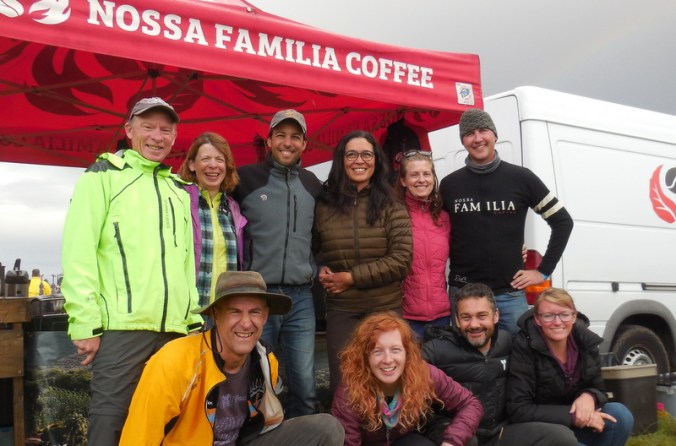
Crew for first 3 days – Top R-L: Dave, Nancy, Augusto, Tia, Christine, Brad Bottom L-R: Kris, Kiersten, De(l)vin, Karen
I think you chose the best day to drive the van. Looking at posts from a couple other people who I know who rode Cycle Oregon you had blue bird day to ride Crater lake.
See next post, Crater Lake was stunning.
That’s the largest Press coffee-maker I’ve ever thought about or seen! Glad your ride around Crater lake was a gorgeous dry day!
You should try lifting it when it’s full of scalding water! Fun!
Brewmaster is definitely the most strenuous, in my opinion. But you do get the benefit of the burner at your feet every morning, so… anyway, you’re a natural.
Physically strenuous for sure, maybe not as mentally challenging as front of house. Either way, all good fun. We had a blast.
Nice write-up, Dave. I am bookmarking it for next year, so I can jog my memory on how to do things the right way and how not to do things the wrong way! Oh, and thanks for omitting the watertank overflow/flooding incident in your list of oopsies!
I think I might have forget to mention burning the hot water container as well – what goes on Cycle Oregon, stays on Cycle Oregon!